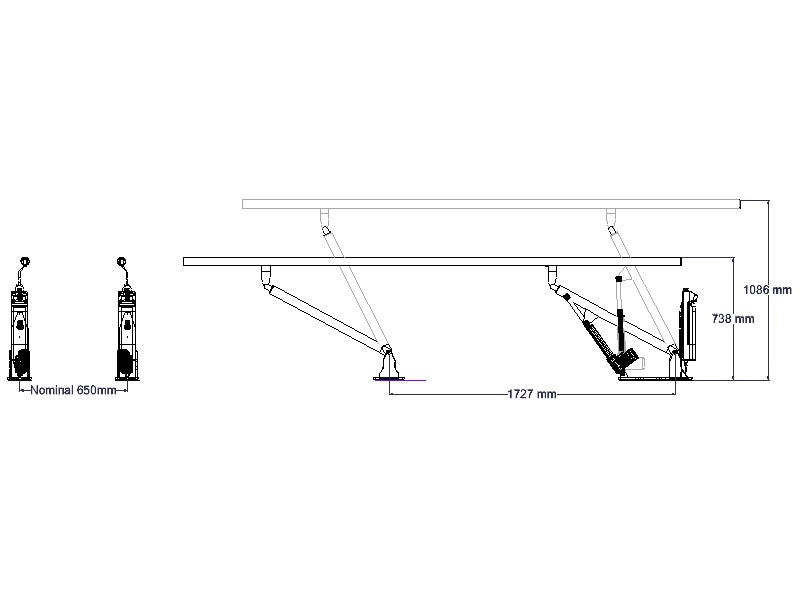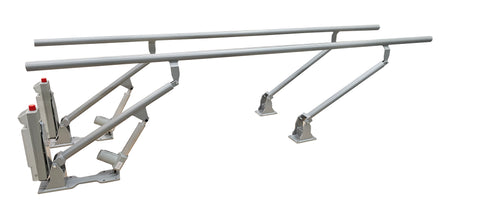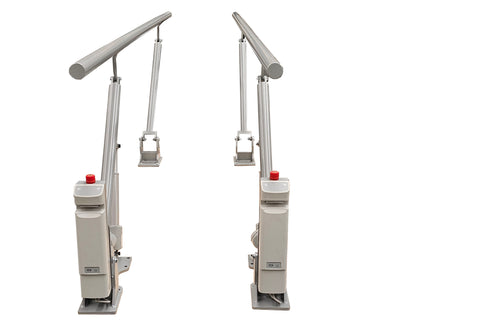Details
Discover the ABCO Electric Walking Rails | Parallel Bars, designed and manufactured in Australia with a reliable 5-year warranty. These rails are completely battery-operated, eliminating the need for electrical cables. The powerful 4Ah battery only requires an overnight charge once a week. With adjustment switches on the top of the battery mount, you can easily modify the height, which ranges from 73cm to 110cm. The rails offer minimal lateral movement of just 35cm over the entire height range, ensuring stability. Dual mounting points at the base provide maximum rigidity. Available in lengths of 3m, 4m, 5m, and 6m, with other lengths available on request, these rails have a lifting capacity of 200kg per rail
SKU: WRFEB.30EF0.73
Height Adjustment Range: 730-1100mm
SKU: WRFEB.30EF0.73
Dimensions and Adjustment
Height Adjustment Control - Hand control
Height Adjustment Range - 730-1100mm
Overall Length - 3000mm
Distance between rails - Recommended 650mm at rail height
Maximum Lifting Capacity per rail - 200kg Dynamic / 400kg Static
Frame
Frame Material - Heavy steel plate and tube
Frame Colour - Light solver
Rails - These rails feature smooth round (42mm) powder coated handrails for user comfort and good looks.
Electrical Requirements
Electrical Approvals - Medically approved according to EN60601-1/ AS3200
Electrical Requirements Supply - 100-240vAC 50/60Hz max 4amp
Electrical Requirements Operation - 4Ah removable Battery for each rail supplied by mains charging - 24vDC max 70VA
General
Shipping Dimensions - 408 x 81 x 51cm / 50kg. Site to Site full-service delivery only
Weight - 60kg
ARTG - 112806
Warranty - 5 years. Parts only
ABCO Health Care has a policy of continuous improvement. Specifications are subject to change without notice.
Schematic Drawing:

Spec: Where can I buy ABCO Health care products?
We ship direct to all parts of Australia from our factory in Melbourne.
Please place your order on-line here.
Can I trial an ABCO Health Care product before purchase?
We do not offer a trial service.
However, we are confident in our products and have a generous Returns policy.
Getting Ready for Use
Your Walking Rails will be delivered fixed to a pallet.
Unpack your Walking Rails after checking for any transit damage.
Familiarise yourself with your Walking Rails by reading the enclosed User Instructions.
Some minor assembly is required - instructions are in the packages.
Position the bases upright where they will be used. Fixing holes are positioned at each corner of the base plates. It is important to ensure that the base plates on each rail are the correct distance apart and parallel.
Install the battery in each holder after charging - rails height is adjusted using the buttons on top of each battery holder.
Your Walking rails are now ready for use.
Specifications
ABCO Health Care has a policy of continuous improvement.
Specifications and Prices are subject to change without notice.
I have a particular requirement that I cannot see on you site
As the manufacturer we are able to offer a variety of custom options including non-standard lengths and widths for an extra cost.
Please use our On-line Chat or our Contact Form describing your requirements.
Returns and Claims
You can return your purchase for refund within 30 days of delivery.
Any returns only after authorisation by ABCO.
All returns at your expense with packaging as new and subject to a 15% restocking fee.




![The essential Guide to picking your Pilates Reformer [2025]](http://abcohc.com.au/cdn/shop/articles/abco-pilates-guide.webp?v=1742176339&width=480)

